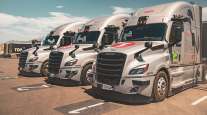States Passing Legislation to Clear Way for Platooning Tests

This story appears in the July 11 print edition of iTECH, a supplement to Transport Topics.
Regulators and elected officials are beginning to carve out a framework that could help pave the way for the real-world use of vehicle platooning and automation.
Much of the focus, especially at the state level, centers on truck platooning, which uses wireless technology to synchronize the braking and acceleration of two or more trucks traveling in tight convoys to improve aerodynamics and reduce fuel consumption.
Legislation that would help clear the path for platooning tests has passed in Florida, Missouri and Utah and is under consideration in Michigan and Pennsylvania.
Nevada and Virginia have approved it via regulatory action.
Peloton Technology has demonstrated platooning recently in Alabama and in Texas on Interstate 45 near San Antonio in conjunction with Texas A&M University.
CHAT WITH SETH: TT Technology Editor Seth Clevenger takes your questions, noon EDT, July 18
BEST OF JULY iTECH: More stories, columns
The Texas Department of Transportation is working with Arizona, California and New Mexico in hopes of launching another platooning test, the Western States Connected Freight Initiative, which would showcase streamlined truck travel from Houston to Los Angeles.
“It’s a watershed time in legislative and regulatory activity related to all manner of connected and automated vehicles,” said Steve Boyd, co-founder and vice president of external affairs at Peloton, which aims to commercially launch its platooning system in North America next year.
Josh Switkes, co-founder and CEO at Peloton, said platooning generally can be approved through administrative action in about 30 states that do not specify a minimum following distance for trucks. However, states with set following distances, typically regulated at 300 feet, would require legislative action to permit platooning.
Peloton has conducted several platooning tests, including one in Utah last November. Which form of truck automation would you most readily embrace?
“As soon as next year, I believe we’ll have commercial operations in platooning,” said Richard Bishop, who is principal at Bishop Consulting and also is affiliated with Auburn University, one of the prime autonomous vehicle research sites along with the University of California-Berkeley. “There are enough states where it’s allowed that there will be a market for the right fleets with the right operations.”
Florida passed a law this spring that calls for a platooning study before a possible pilot, which Ed Hutchinson of the state’s DOT hopes will begin next spring. Hutchinson said the study will address such issues as the effect on pavement and bridges, where to test, which lanes to use and what following distance to establish.
Legislation to suspend the 300-foot following distance passed overwhelmingly in Missouri this spring, but even James Pflum, the technology’s biggest proponent in the state’s DOT, didn’t celebrate.
“You’re venturing into an arena that doesn’t really exist, so policies and regulations do need to be looked at,” Pflum said. “We’re taking the testing route because we want to be optimistic but not try to implement something that hasn’t been [fully] tested. It’s kind of a state-by-state thing now, but I think it will kind of a snowball once you start seeing the successes.”
While testing has been conducted in controlled environments and sparsely populated areas, Pennsylvania officials believe their more heavily trafficked state offers a more sensible alternative.
“One of the reasons that Pennsylvania is attractive is because we are real world,” said PennDOT Deputy Secretary Kurt Myers, who also hopes to have testing in his state in 2017. “We have hills. We have bad weather. We have traffic. If companies only test where there are no hills, where there is no snow, where there is no traffic, that may prove part of the technology, but it doesn’t prove the ability of that vehicle to go into operation in real-world situations.
“The [field] is changing incredibly rapidly, and state regulations can’t keep pace. So our policy is testing first and at some point down the road, actual operation of the vehicles on the highway. Our focus is balancing the testing of this new technology with safety.”
The U.S. Department of Transportation has not issued any regulations, although the National Highway Traffic Safety Administration is expected to release documents this summer that it said will serve as the foundation for such rules on autonomous vehicles.
“Connected-vehicle technology has the potential to prevent many of the tens of thousands of automotive-related deaths that occur every year in the U.S. based on the safety benefits,” DOT press secretary Clark Pettig said.
Andrew Laquet, a transportation attorney with Roberts Perryman in St. Louis, said automation is a growing trend across the entire economy.
“Trucking is one of the places where we’ll probably see a lot of that happening,” he said. “The driver shortage will probably accelerate that demand during the next few years. Platooning saves fuel, which is one of trucking’s big expenses. It can potentially free truckers to do other things while they’re driving. The job … will change. It might be more attractive for people to get into the industry.”
“The technology is ready; it’s the policy and the regulations that need to catch up,” said Jeff Baer, CEO of LinkeDrive, a technology firm focused on safe and efficient driving. “We don’t know about liability, etc. [But] if a machine can make [driving] safer than a man, then it’s go time.”
American Trucking Associations recently organized a task force within its Technology and Engineering Policy Committee to consider whether to develop a formal policy on autonomous trucks and platooning.
“Platooning is a crawling step towards automated trucks,” said Ted Scott, ATA’s director of engineering services. “I think the next logical step will be lane centering/lane control. That will allow for some removal of the driver’s hands from the steering wheel. Is a driver still a driver when that happens? What will he be paid? How is he going to be insured? There are so many unknowns.”




